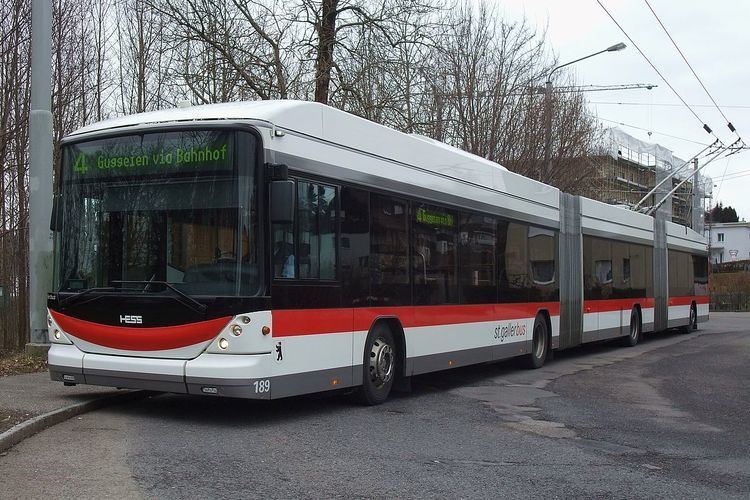Status Open Electrification 600 V DC | Routes 4 | |
 | ||
Open 18 July 1950 (1950-07-18) Operator(s) Verkehrsbetriebe der Stadt St. Gallen (VBSG) | ||
The St. Gallen trolleybus system (Alemannic German: Trolleybussystem St. Gallen) forms part of the public transport network of St. Gallen, the capital city of the canton of St. Gallen, Switzerland.
Contents
Opened in 1950, the system is currently operated by Verkehrsbetriebe der Stadt St. Gallen (VBSG). As of 2012, it consists of a cross-city line and three radial lines, all of which meet at St. Gallen railway station, and has a total route length of 22.6 km (14.0 mi).
History
In the 1950s, the trolleybus system gradually replaced the St. Gallen tramway network. The last tram ran on 30 September 1957. The individual trolleybus line sections went into service as follows:
Lines
The present system is made up of the following lines:
To this day, the Trogenerbahn (Trogen Railway) runs through the inner city between the station and Brühltor on the rails of the former tramway, and thus parallel to the trolleybuses. The two modes of transport still share a common electrical substation. In the relevant section of the common route, the overhead wire voltage is only 600 V DC, as is the rest of the trolleybus system. By contrast, the remainder of the Trogenerbahn route is energised at 1,000 V DC.
In Riethüsli, the terminus of Line 5, there is an interchange station for changing between the trolleybus system and the electrically operated St. Gallen–Gais–Appenzell railway line. At that station, the two systems use common overhead catenary poles and suspension wires for about 300 m (980 ft), but are electrically isolated from each other.
Line 4 has existed only since 9 December 2007. Previously, line 1 had had three different termini from 1991, and four from 1996.
Retired fleet
The original group numbered 101–118, the fleet that opened the system in 1950, were rebodied by Hess between 1968 and 1975 and fitted with a new backup battery. They were simultaneously renumbered as fleet nos. 131–148, but not in the same sequence. Trailer operations ended either in 1991 or in March 1992.
Disposal abroad
Current fleet
A total of 25 trolleybuses are currently available for use on the St. Gallen system; a maximum of 21 are required simultaneously. The present fleet comprises 17 articulated buses and eight bi-articulated buses, all of which are of low-floor design:
Fleet no. 155, which was originally a single-articulated, high-floor trolleybus, is an exceptional vehicle. Fourteen years after its entry into service, it was lengthened into a bi-articulated vehicle, by the addition of a second, low-floor, trailing segment. Simultaneously, its designation was changed from BGT 5-25 to BGGT 5-25.
Originally it was planned to carry out a similar conversion to eight or nine other vehicles of this type. However, due to technical problems with the prototype, it was decided instead to purchase the seven brand-new bi-articulated trolleybuses, nos. 188 to 194.
The bi-articulated vehicles provide a large proportion of the services on lines 1 and 4, although no. 155 runs solely on line 1. By contrast, only normal articulated trolleybuses are used on lines 3 and 5, except on one occasion when bi-articulated vehicles were used on line 3 during a special exhibition.
